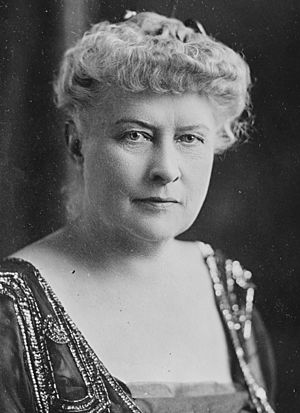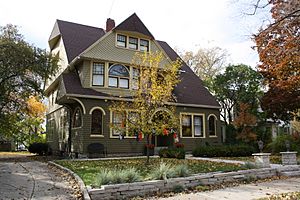Jessie Jack Hooper facts for kids
Quick facts for kids
Jessie Jack Hooper
|
|
|---|---|

Hooper c. 1900
|
|
| Born | November 9, 1865 |
| Died | May 7, 1935 (aged 69) Oshkosh, Wisconsin
|
| Known for |
|
| Spouse(s) | Ben Hooper |
| Relatives | Lois Van Valkenburgh (granddaughter) |
Jessie Annette Jack Hooper (born November 9, 1865 – died May 7, 1935) was an American activist. She worked hard for peace and for women's right to vote. She was the first president of the Wisconsin League of Women Voters. In 1922, she ran for a seat in the United States Senate. This campaign inspired her to gather women's groups to ask for world disarmament.
Contents
Early Life and Family
Jessie Hooper was born on November 9, 1865, in Winneshiek County, Iowa. Her father, David Jack, was a rich businessman. Jessie was taught at home by a special teacher called a governess. She later remembered her father's strength during a tough time for his business. She said his "indomitable qualities" (meaning his strong spirit) always made her feel better if she felt discouraged.
In 1888, Jessie married Ben Hooper, a lawyer from Oshkosh, Wisconsin. He supported her interest in helping the community.
Fighting for Women's Right to Vote
In 1893, Jessie Hooper and her young daughter went to the Chicago World's Fair. There, they heard a speech by the famous women's rights leader, Susan B. Anthony.
It wasn't until 1908 that Jessie held an elected role in a community group. Her husband encouraged her to join the local Daughters of the American Revolution. Even though she was a bit shy, she won easily. She then held many positions in what were called "women's clubs".
At first, she focused on making health care better in places where there was none. She found this work difficult. Men often only got involved after her efforts had already succeeded.
We found men in charge of our city government, while always polite to us, had little interest in what we wanted because we had no votes. I soon got tired of joining pilgrimages to officials where we rarely got what we asked for, and decided to concentrate my efforts on securing the vote for women.
Jessie soon realized that women needed the right to vote to make real changes. She began to work seriously for women's suffrage (the right to vote). She spent time in Washington D.C., living with other well-known suffragists.
In 1919 and 1920, Jessie Hooper traveled with Minnie Fisher Cunningham. They visited Arizona, Nevada, New Mexico, and Utah. They urged the governors of these states to hold special meetings. The goal was to approve the Nineteenth Amendment to the United States Constitution. This amendment would give women the right to vote across the country.
After the Nineteenth Amendment was approved in 1920, the National American Women's Suffrage Association (NAWSA) became the League of Women Voters. In Wisconsin, the League's motto was "every woman an intelligent voter." Jessie Hooper served two terms as its very first president.
Running for the U.S. Senate
In 1922, the Democratic Party in Wisconsin chose Jessie Hooper to run for the United States Senate. She ran against the Republican leader, Robert M. La Follette.
Her campaign was managed by two women, Livia Peshkova and Gertrude Watkins. Women in the news also supported her. Her campaign events were often held in people's living rooms. The rallying cry for her campaign became "Whoop for Hooper!"
Jessie's campaign focused on several key ideas. She supported the League of Nations, which was an international group working for peace. She also wanted better support for veterans (people who had served in the military). Most importantly, she championed world peace. At this time, she was a grandmother. She also worked as an unpaid secretary and partner in her husband's business. Her husband was one of only two men who gave money to her campaign.
Jessie Hooper lost the election. She received 78,029 votes, while La Follette received 279,484 votes. However, this experience made her even more determined to get women involved in working for peace.
Working for World Peace
Jessie Hooper's efforts for world peace began during World War I. She strongly believed that all wars should end. Even though she lost the Senate election, it pushed her to recruit women for peace activism.
In 1924, Hooper invited 115 women from all over the country to a meeting. This meeting led to the creation of the Conference on the Cause and Cure of War. This group met for several years to discuss how to prevent wars.
Jessie was chosen to lead the Department of International Relations of Women's Clubs. She also led the Wisconsin League of Women Voters' Committee for International Cooperation to Prevent War. She eagerly worked to gather one million signatures asking for military disarmament (reducing weapons and armies). She traveled across the country, giving speeches and talking on the radio. She also wrote newspaper columns to promote peace.
Her effort didn't quite reach one million signatures, but she still gathered 635,300. In 1932, Jessie Hooper was chosen to present these petitions to the World Disarmament Conference in Geneva, Switzerland.
Later Life and Legacy
Jessie Hooper continued to work for peace after she returned from Switzerland. In 1934, she was hospitalized. She returned home but lived only a few more months. Jessie Hooper died on May 7, 1935.
The Jessie Jack Hooper House in Oshkosh, Wisconsin was added to the National Register of Historic Places in 1978. This means it is an important historical building.
Her granddaughter, Lois Van Valkenburgh, became a civil rights activist.


